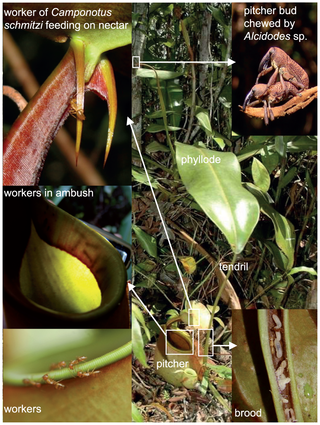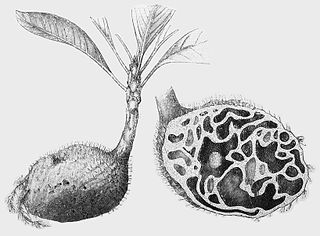
Philodendron is a large genus of flowering plants in the family Araceae. As of September 2015, the World Checklist of Selected Plant Families accepted 489 species; other sources accept different numbers. Regardless of number of species, the genus is the second-largest member of the family Araceae, after genus Anthurium. Taxonomically, the genus Philodendron is still poorly known, with many undescribed species. Many are grown as ornamental and indoor plants. The name derives from the Greek words philo- 'love, affection' and dendron 'tree'. The generic name, Philodendron, is often used as the English name.

Matthew Hilary Peter Jebb is an Irish botanist and taxonomist specialising in the ant plant genera Squamellaria, Myrmecodia, Hydnophytum, Myrmephytum and Anthorrhiza, as well as the carnivorous plant genus Nepenthes.

Myrmecodia is a genus of epiphytic myrmecophytes, native to Southeast Asia and present in Indochina, Malaysia, the Southwest Pacific, the Philippines, and extending south to Fiji and Cape York in Queensland, Australia. It is one of five ant-plant genera in the family Rubiaceae, the others being Anthorrhiza, Hydnophytum, Myrmephytum, and Squamellaria.

Hypochrysops is a genus of butterflies in the family Lycaenidae first described by Cajetan Felder and Rudolf Felder in 1860. This particular genus is exclusive to the Australian area with only a few species straying into Papua New Guinea.

A domatium is a tiny chamber that houses arthropods, produced by a plant.

Stemona tuberosa is a species of flowering plant in the family Stemonaceae. It is native to China, India, southeast Asia, and New Guinea. Hornets play an important role in seed dispersal by biting off the seed with its elaiosome and then carrying the seed away for about 100 m. There they chew off the elaiosome and abandon the seed which is likely to be taken by ants into their nest.

Melaleuca viridiflora, commonly known as broad-leaved paperbark, is a plant in the myrtle family Myrtaceae, and is native to woodlands, swamps and streams in monsoonal areas of northern Australia and New Guinea. It is usually a small tree with an open canopy, papery bark and spikes of cream, yellow, green or red flowers.

Lecanopteris is a genus of ferns in the family Polypodiaceae, subfamily Microsoroideae, according to the Pteridophyte Phylogeny Group classification of 2016 (PPG I). They have swollen hollow rhizomes that provide homes for symbiotic ants. All are epiphytic plants that naturally occur from Southeast Asia to New Guinea. Several species are in commerce, being grown as houseplants and greenhouse curiosities.

Myrmecotrophy is the ability of plants to obtain nutrients from ants, a form of mutualism. Due to this behaviour the invasion of vegetation into harsh environments is promoted. The dead remains of insects thrown out by the ants are absorbed by the lenticular warts in myrmecophytes like Hydnophytum and Myrmecodia. Myrmecodia uses its lenticular warts to suck nutrients from the insects thrown out by the ants. The ants in turn benefit with a secure location to form their colony. The pitcher plant Nepenthes bicalcarata obtains an estimated 42% of its total foliar nitrogen from ant waste.

Myrmecodia beccarii, ant-house plant, is an epiphytic plant on Melaleuca trees and others with spongy bark in the wetlands and mangroves of tropical north Queensland, Australia from Cooktown to Mission Beach. The prickly, swollen stems develop natural hollows which are invaded by the golden ant in a symbiotic arrangement. The ants patrol the plant, removing leaf-eaters, while their excreta is absorbed by the plant for nutrition.

Hydnophytum is a genus of epiphytic myrmecophytes native to Southeast Asia, the Pacific region and also extending into Queensland in northern Australia. The name is derived from the Ancient Greek hydnon "tuber", and phyton "plant", after their appearance with their swollen succulent stems. The species grow in tree branches and on trunks. Like the related genus Myrmecodia, they are known as antplants or ant-house plants. The type species is Hydnophytum formicarum from the Philippines. The genus contains 55 species, of which 44 are found in and around the island of New Guinea. Many are poorly known, with 11 known only from the holotype.

In plant morphology, thorns, spines, and prickles, and in general spinose structures, are hard, rigid extensions or modifications of leaves, roots, stems, or buds with sharp, stiff ends, and generally serve the same function: physically defending plants against herbivory.

The acacia ant is a species of ant of the genus Pseudomyrmex. These arboreal, wasp-like ants have an orange-brown body around 3 mm in length and very large eyes. The acacia ant is best known and named for living in symbiosis with the bullhorn acacia throughout Central America.
Myrmephytum is a genus of myrmecophytic flowering plants in the family Rubiaceae. It is distributed from central Malesia to New Guinea.

Squamellaria is a genus of myrmecophytic flowering plants in the family Rubiaceae. It includes eight species native to the Solomon Islands, Vanuatu, and Fiji.

Psychotrieae is a tribe of flowering plants in the family Rubiaceae and contains about 2114 species in 17 genera. Its representatives are found in the tropics and subtropics. Several genera are Myrmecophytes

Lecanopteris sinuosa is a fern that belongs to the fern genus Lecanopteris. This epiphytic plant has a mutualistic relationship with stingless shelter ants, which makes it a myrmecophyte.

Philidris cordata is a species of ant in the genus Philidris. Described by Smith in 1859, the species is endemic to Indonesia and New Guinea. This species is a frequent inhabitant of the ant plant genera: Myrmecodia and Hydnophytum.

Pachycentria glauca is a small epiphytic shrub in the Melastomataceae family. It has 2 subspecies: P. glauca subsp. glauca and P. glauca subsp. maingayi. The glauca subspecies is endemic to Borneo, the maingayi subspecies is native to Peninsular Malaysia and Thailand, perhaps Sumatra. It grows on trees, other epiphytes and rocks in partial shade. It is intimately associated with particular ant species, growing on their gardens, providing a home for them, feeding them and having its seeds dispersed by them.
An ant garden is a mutualistic interaction between certain species of arboreal ants and various epiphytic plants. It is a structure made in the tree canopy by the ants that is filled with debris and other organic matter in which epiphytes grow. The ants benefit from this arrangement by having a stable framework on which to build their nest while the plants benefit by obtaining nutrients from the soil and from the moisture retained there.




















